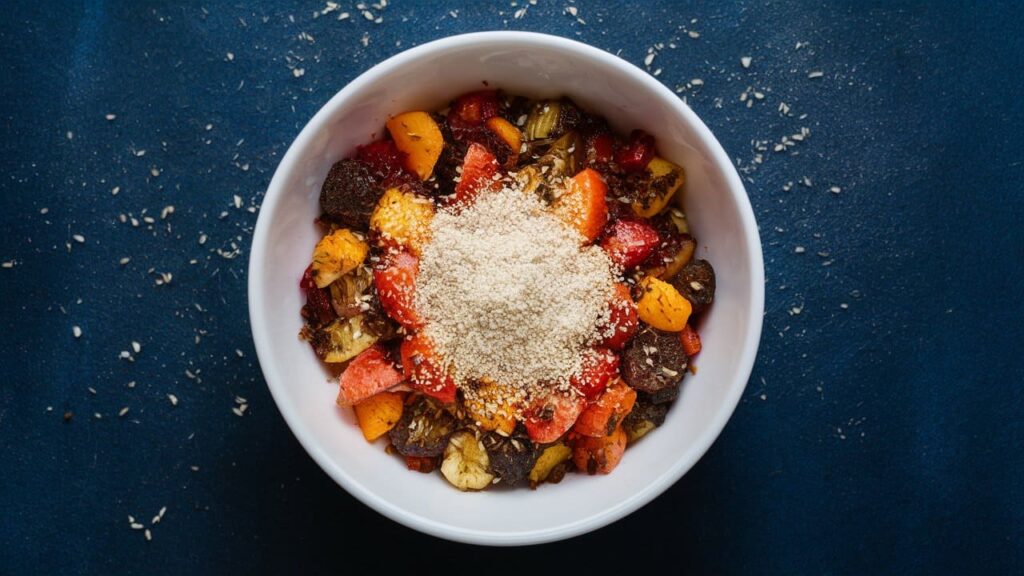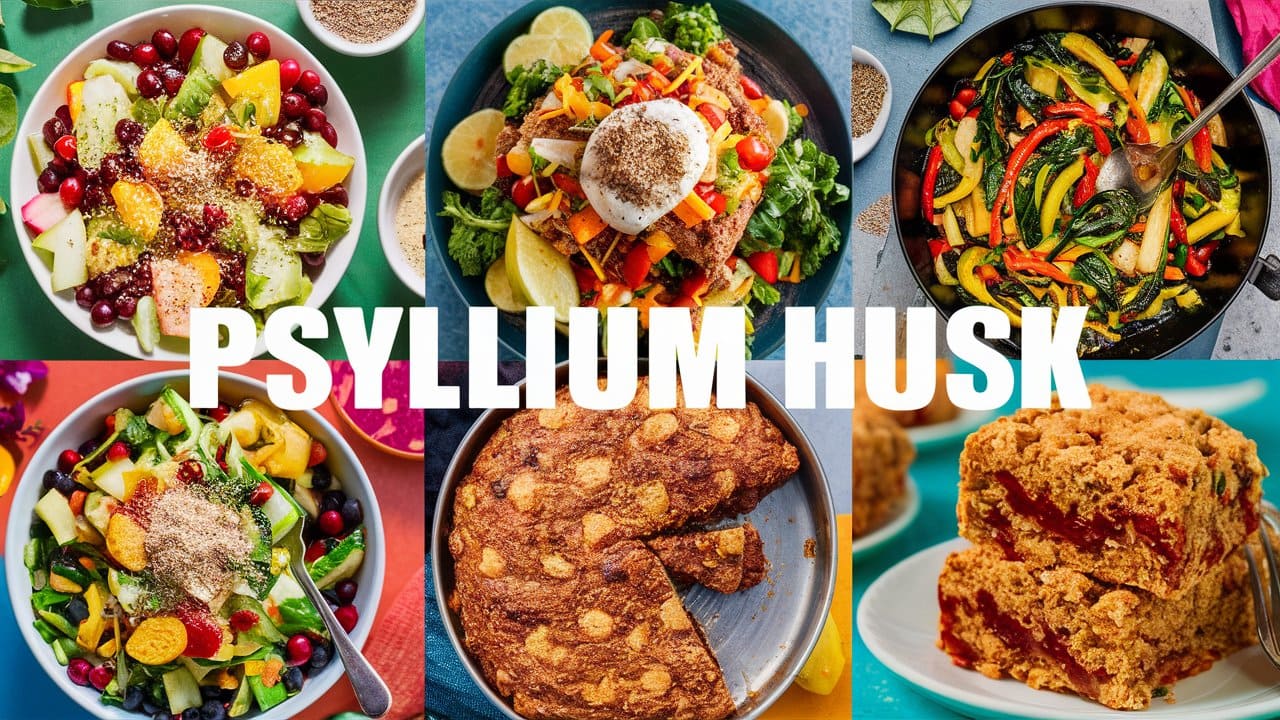Psyllium husk, a form of fiber derived from the seeds of the Plantago ovata plant, has become a staple in health-conscious kitchens worldwide. Known for its impressive health benefits, including aiding digestion and lowering cholesterol, psyllium husk can be creatively incorporated into various recipes. This article will explore innovative and delicious ways to integrate psyllium husk into your meals, ensuring you reap all its nutritional benefits without compromising on taste.
The Basics of Psyllium Husk
What is Psyllium Husk?
Psyllium husk is a soluble fiber that absorbs water and becomes a viscous compound that benefits the heart, pancreas, and digestive system. It is commonly used as a dietary supplement but is increasingly being incorporated directly into foods due to its minimal flavor and versatile texture.
Health Benefits of Psyllium Husk
- Digestive Health: It promotes regularity and helps to prevent constipation.
- Cholesterol Reduction: It can help lower bad cholesterol levels, thus reducing the risk of heart disease.
- Blood Sugar Control: Psyllium helps manage blood sugar levels, making it beneficial for diabetics.
How to Incorporate Psyllium
Adding psyllium husk to your diet is straightforward. It can be mixed into water, juices, smoothies, and more. However, it is also versatile enough to be baked into breads, mixed into breakfast cereals, and even added to soups and stews as a thickening agent.
Psyllium Husk Breakfast Recipes
Psyllium Husk Pancakes
Start your day with psyllium husk pancakes, which are fluffy, nutritious, and perfect for a fiber-rich breakfast. Combine psyllium husk with almond flour, eggs, milk, and a touch of vanilla for a healthful twist on a breakfast classic. This recipe not only satisfies your morning appetite but also stabilizes blood sugar levels throughout the day.
High-Fiber Smoothies
- Berry and Banana Smoothie: Blend frozen berries, a banana, a tablespoon of psyllium husk, yogurt, and almond milk for a delicious and filling smoothie. This drink is perfect for a quick breakfast or a refreshing snack, offering a high-fiber boost.
- Green Detox Smoothie: For a detoxifying effect, mix kale, spinach, green apple, cucumber, lemon juice, and psyllium husk with water. This green smoothie cleanses the digestive system while providing essential nutrients.
Oatmeal with Psyllium Husk
Elevate your morning oatmeal by stirring in a teaspoon of psyllium husk. It not only increases the fiber content but also helps in thickening the oatmeal, making it even more satisfying. Add some fresh fruits, nuts, and a drizzle of honey for a balanced and heart-healthy breakfast.
Psyllium Husk Main Dishes
Psyllium-Enhanced Meatballs
Incorporate psyllium husk into your meatball recipe to add fiber without altering the flavor. Mix ground meat with psyllium husk, garlic, onion, herbs, and spices, then bake or fry as usual. The psyllium husk helps bind the meatballs together while adding a fiber boost.
Vegetarian Burger Patties
Create a vegetarian burger that doesn’t fall apart on the grill by adding psyllium husk as a binding agent. Combine cooked quinoa, black beans, chopped vegetables, spices, and psyllium husk to form patties. The psyllium husk keeps the ingredients intact and enhances the fiber content of your veggie burger.
Gluten-Free Pizza Crust
For those on a gluten-free diet, psyllium husk can create a pizza crust that is both delicious and easy to handle. Mix psyllium husk with gluten-free flour, yeast, and water to form a dough. This psyllium-based crust provides a chewy texture similar to traditional pizza dough, plus an added fiber bonus.
Psyllium Husk in Soups and Stews
Thickening Soups Naturally
Psyllium husk is an excellent natural thickener for soups and stews. Unlike traditional thickeners like flour or cornstarch, psyllium husk does not alter the taste and adds significant fiber content. Simply sprinkle a small amount into your pot towards the end of cooking to achieve a thicker, more satisfying texture.
Creamy Vegetable Soup
Create a creamy vegetable soup without heavy cream by using psyllium husk. Blend cooked vegetables such as broccoli, carrots, and potatoes with vegetable broth, then add a teaspoon of psyllium husk to thicken the mixture as it simmers. The result is a creamy, comforting soup packed with nutrients and fiber.
Hearty Beef Stew
Enhance a traditional beef stew with psyllium husk. After browning the beef and sautéing the vegetables, add your broth and a tablespoon of psyllium husk. The psyllium will help thicken the stew as it cooks, adding a rich texture and boosting the fiber content, making it a more heart-healthy dish.
Psyllium Husk in Baked Goods
Gluten-Free Bread
Psyllium husk is a game-changer for gluten-free baking. It helps mimic gluten’s properties by providing structure and elasticity. Combine psyllium husk powder with gluten-free flours, yeast, and water to bake a loaf of bread that has a pleasing texture and is easy to slice, unlike many other gluten-free breads that tend to be crumbly.
Healthy Cookies
Bake fiber-rich cookies with psyllium husk. Use it in recipes for oatmeal cookies, adding raisins and cinnamon for flavor. Psyllium husk not only helps bind the cookies, preventing them from crumbling but also adds a substantial amount of fiber, which is great for digestive health.
Psyllium Husk Muffins
Introduce psyllium husk into your muffin recipes to increase their nutritional value. Whether you’re making blueberry, banana, or chocolate chip muffins, adding a small amount of psyllium husk can improve the texture and fiber content. These muffins make a perfect snack or a quick breakfast option, providing you with lasting energy.
Practical Tips for Cooking with Psyllium Husk
Hydration is Key
When using psyllium husk in recipes, it’s important to increase the amount of liquid to accommodate the husk’s absorbent nature. Ensure your doughs and mixtures have enough moisture to prevent them from becoming too dense.
Gradual Addition
Incorporate psyllium husk slowly into your diet. Start with small amounts in your recipes to allow your digestive system to adjust. Too much psyllium husk too quickly can lead to gastrointestinal discomfort.
Storage and Shelf Life
Psyllium husk should be stored in a cool, dry place to preserve its efficacy. Properly stored, it can last for several years. Check the expiration date on the package and keep it sealed tightly after each use to maintain its freshness and effectiveness.
Concluding Thoughts on Psyllium Husk Recipes
Diverse Applications
Psyllium husk proves to be a versatile ingredient that can enhance a wide range of recipes. From breakfasts and main dishes to soups and baked goods, its utility in the kitchen is vast due to its health benefits and functional properties as a fiber supplement.
Health Benefits Revisited
Incorporating psyllium husk into your meals not only boosts the fiber content but also helps in managing cholesterol levels, controlling blood sugar, and maintaining digestive health. Its role in a balanced diet cannot be overstated, especially for those looking to improve their intestinal and overall health.
Encouragement to Experiment
We encourage you to start experimenting with psyllium husk in your cooking. Its neutral flavor and gelling capabilities make it an excellent ingredient for those looking to enhance the nutritional profile of their meals without compromising on taste.
By exploring the diverse uses of psyllium husk through these recipes, you can enjoy the benefits of increased dietary fiber while discovering new, delicious ways to enrich your diet. Whether you are aiming to improve digestive health, manage weight, or simply eat cleaner, psyllium husk can be your go-to ingredient for a healthier lifestyle.
Innovating With Psyllium Husk in Snacks and Desserts
Psyllium Husk as a Dessert Ingredient
Psyllium husk’s ability to act as a binder and fiber supplement makes it an excellent addition to various desserts. It helps create healthier versions of your favorite treats by improving texture and adding dietary fiber without altering the flavor.
Energy Bars
Make homemade energy bars by mixing oats, nuts, seeds, dried fruit, and psyllium husk with honey or agave as a binder. These bars are perfect for a quick energy boost before a workout or as a healthy snack during the day. The addition of psyllium husk increases the fiber content, which aids in sustained energy release.
Fruit Crumbles
Add a healthy twist to traditional fruit crumbles by including psyllium husk in the topping. Mix it with almond flour, oats, cinnamon, and a little bit of butter to create a satisfying, crunchy texture that complements the softness of the baked fruit underneath. This not only enhances the dish’s fiber content but also helps in creating a more cohesive crust that holds its shape better.
Healthy Puddings
Psyllium husk can transform a simple pudding into a fiber-rich dessert. Whether you’re making chocolate, vanilla, or fruit pudding, adding a teaspoon of psyllium husk can improve its consistency while boosting its health benefits. Serve these puddings as a guilt-free dessert that satisfies your sweet tooth and your dietary needs.
Seasonal Recipes Featuring Psyllium Husk
Summer Refreshments
In the summer, use psyllium husk to make refreshing fruit gels. Combine it with pureed fruit and a little sweetener, then let it set in the fridge. Serve cold for a refreshing treat that’s both hydrating and fiber-rich, perfect for hot days.
Autumn Bakes
Incorporate psyllium husk into your autumn baking to add nutritional value to pies and pastries. It works well in pumpkin pie, apple tarts, and other seasonal favorites, improving texture and adding fiber without compromising taste.
Winter Warmers
During the colder months, add psyllium husk to your homemade soup recipes to thicken them without the need for cream or flour. It’s especially great in hearty recipes like split pea soup or beef stew, where it adds a subtle thickness and boosts the fiber content, making each spoonful even more satisfying.

Special Diet Considerations with Psyllium Husk
Gluten-Free Cooking and Baking
Psyllium husk is a boon for gluten-free diets. Its binding properties make it an ideal substitute for gluten in baked goods, helping to mimic the structure and texture that gluten typically provides. From bread to cookies, psyllium can help achieve the desired consistency without any gluten.
Low-Carb Diets
For those on low-carb diets, psyllium husk can replace flour in various recipes, reducing the carbohydrate content while still allowing for satisfying meals. Use it in everything from pancakes to pizza bases as a low-carb, high-fiber alternative.
Vegan Recipes
Psyllium husk is also incredibly valuable in vegan cooking, acting as a binding agent in place of eggs. It can be used to hold together patties, meatballs, and vegan baking recipes, ensuring they don’t crumble while adding beneficial fiber.
Conclusion: The Versatile Power of Psyllium Husk
The Culinary Potential of Psyllium Husk
As we’ve explored throughout this guide, psyllium husk is not only a health powerhouse but also a versatile kitchen ingredient. Its ability to enhance the nutritional profile of meals without altering flavor makes it an invaluable addition to any diet.
Health Reaffirmed
Regular inclusion of psyllium husk in your diet can contribute significantly to digestive health, cholesterol management, and overall well-being. It’s a simple way to increase your fiber intake, which is essential for maintaining good health.
Encouragement for Innovation
Experimenting with psyllium husk can open up a world of culinary possibilities. Whether you’re a seasoned chef or a home cook, the recipes and tips provided here can inspire you to create innovative dishes that are both delicious and nutritious.
In summary, psyllium husk offers more than just health benefits; it provides a gateway to exploring new and exciting ways to cook and bake. By incorporating it into your recipes, you can enjoy a range of dishes that support your health and satisfy your palate. Embrace the versatility of psyllium husk and make it a staple in your dietary arsenal.
You can get more recipes from here:

